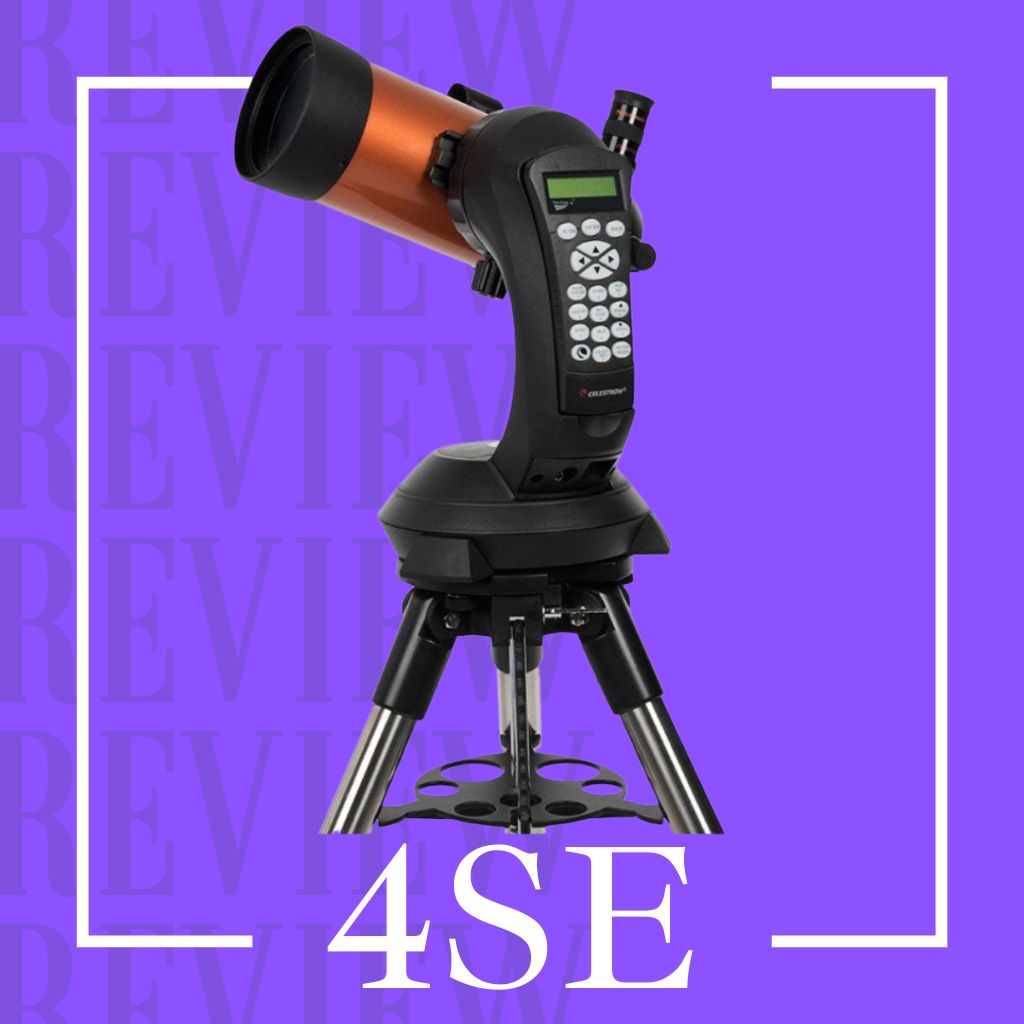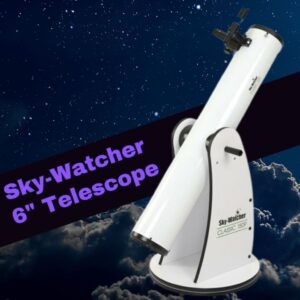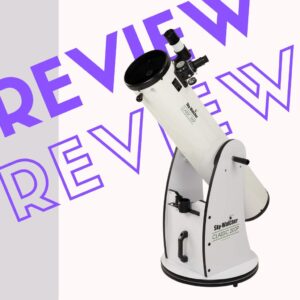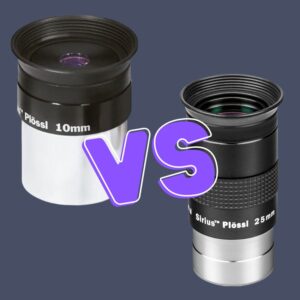This site contains affiliate links to products. I may receive a commission for purchases made through these links.
Celestron Nexstar 4SE is a Maksutov Cassegrain telescope with a 4-inch (102mm) aperture and 52-inch (1325mm) focal length. It is mounted on a motorized goto mount. The mount is an alt-azimuth type, but you can also use it as an equatorial mount with a built-in equatorial wedge. This is a unique feature of this telescope because you have two mount types in one package.
Celestron Nexstar 4SE is the smaller brother of the great Schmidt Cassegrain telescope Celestron Nexstar 8SE. If you don’t have a budget for an 8SE, get the 4SE.
This review will show you what you can expect from this nice little telescope.
Celestron NexStar 4SE specifications
| Design | Maksutov-Cassegrain Catadioptric |
| Aperture | 4 inches (102mm) |
| Focal Length | 52 inches (1325mm) |
| F/ratio of the Optical System | 13 |
| Primary Mirror | 102mm |
| Secondary Mirror Spot Size | 1.25″ |
| Highest Useful Magnification | 240x ( ~ 6mm eyepiece) |
| Lowest Useful Magnification | 15x ( ~ 80mm eyepiece) |
| Optical Tube Length | 13.5 inches |
| Weight of Telescope | 11 Lbs. |
| Weight of Tripod | 10 lbs |
| Ports | RS-232 communication port on hand control |
| Tracking Rates | Sidereal, Solar, Lunar and King |
| Tracking Modes | Alt-Az, EQ North & EQ South |
| Alignment Procedures | SkyAlign, Auto Two-Star, Two-Star, One-Star, Solar System Align |
| Database | 25 user-defined programmable object. Enhanced information on over 100 objects |
| Total Object Database | 38,181 |
Celestron NexStar 4SE optional accessories
A few optional accessories for this telescope, like the Goldline eyepieces or Barlow lens, are necessary, not optional, to get the most out of the 4SE telescope.
The DC power adapter is also a good idea but optional. You can use this telescope on AA batteries alone with no issues.
I would also replace this telescope’s red dot finder with the proper or Telrad finder scope. The red dot finder is, well, a crap toy.
Another cool optional accessory is the Celestron WiFi adapter called Celestron SkyPortal WiFi Module. It will allow you to control your telescope with your smartphone or computer over the WiFi network.
Celestron NexStar 4SE built-in equatorial wedge
The Celestron Nexstar 4SE mount is unique because it has a built-in equatorial wedge to transform the alt-azimuth mount into the equatorial mount. It sounds cool, but you may never use it.
It is complicated to set up and polar align. It doesn’t have a polar scope, which makes it even harder. It would be best to have the equatorial mount for long-exposure astrophotography, which, unfortunately, this telescope and mount are not made for.
And transforming it into an equatorial mount and using it for visual astronomy is just stupid. The factory alt-azimuth setup is more than enough for this telescope.
Celestron NexStar 4SE Maksutov-Cassegrain design
Most people need clarification on its look and think it is a Schmidt Cassegrain (SCT) telescope. But the Celestron Nexstar 4SE uses Maksutov Cassegrain (MAK) telescope design.
The Maksutov Cassegrain design is mostly used in combination with smaller aperture telescopes. It has excellent quality optics, sometimes better than SCT.
Still, the thick corrector plate at the front of the Maksutov telescope optical tube assembly is not used in big telescopes. The plate is expensive to manufacture in big sizes, so SCT design takes over big Cassegrain telescopes.
To know more about the difference between SCT and MAK design, read this article Schmidt Cassegrain vs. Maksutov Cassegrain.
What is the main advantage of the Cassegrain Catadioptric design?
One of the Catadioptric Cassegrain design’s shared advantages is that you can squeeze long focal lengths into a small telescope tube.
This design uses mirrors like a Newtonian telescope. But it is a closed design with a corrector plate at the front of the optical tube. The secondary mirror on the plate is parallel to the primary mirror.
That’s why the Celestron Nexstar 4SE telescope tube is only 13.5 inches (343mm) long but has a focal length of 52 inches (1325mm).
The focuser and the eyepiece are at the back of the telescope because the light reflects between the primary and secondary mirror and then goes through the opening in the center of the primary mirror to the eyepiece diagonal.
The 4SE also has an integrated flip mirror at the back of the telescope. It is used to switch between the diagonal with the eyepiece and the opening for a camera, which you can attach to do some astrophotography.
The focusing mechanism is also different from basic reflecting and refracting telescopes. Instead of moving the eyepiece with the focuser, the focuser moves the primary mirror to achieve precise focus alignment.
Read also: Refractor vs Reflector Telescope: What Is The Difference?
What is the magnification you can have on the Celestron NexStar 4SE telescope?
Because of the Maksutov Cassegrain design, the 4SE can provide high magnifications. Magnification is calculated by dividing the telescope’s focal length by the eyepiece’s focal length. Therefore the long focal length of the 4SE is a significant advantage if you are looking for a high-magnification telescope to observe planets.
The 4SE comes only with one eyepiece with a focal length of 25mm. It is a Plossl eyepiece providing 55x magnification. That’s not a lot, but this telescope can handle higher magnification, so I recommend buying an additional smaller eyepiece for higher magnification.
Don’t forget that the highest useful magnification for the Celestron Nexstar 4SE is 240x, so don’t go lower than 6mm eyepiece.
Grab a 9mm or 6mm Goldline eyepiece to get higher magnification. Also, having a good Barlow lens will double your eyepiece collection and will provide more magnification options with one eyepiece.
For example, the 2x Barlow lens will give you 110x magnification with the included 25mm eyepiece. The 3x Barlow lens has 165x magnification with the same eyepiece.
Here are two examples of magnification and field of view you can expect from different eyepieces with the Celestron Nexstar 4SE looking Saturn:
What’s the setup process like for the Celestron NexStar 4SE Telescope, and is it user-friendly?
The Celestron NexStar 4SE is very easy to set up. In just a few steps, you can get the telescope up and running. Here is how to set up the telescope:
- Check contents: Ensure the box contains the computerized telescope, mount, tripod, and other accessories.
- Set up tripod: Extend the tripod legs and place them on the ground. Attach the accessories tray to the threaded rod and ensure the legs rest against the tray arms.
- Adjust tripod height: Loosen the tripod leg locking knob and extend the legs to your desired height.
- Level the mount: Place a bubble level on the mount and adjust the tripod height until level.
- Mount the telescope: Align the telescope base with the mount, ensuring the rubber feet align with the mounting screws. Tighten the mounting bolts.
- Install StarPointer: Slide the StarPointer into its bracket and tighten the side screws. Remove the battery plastic cover.
- Attach eyepiece: Insert and secure the 25 mm eyepiece in the holder.
- Insert batteries: Open the telescope cover, insert 8 AA batteries ensuring correct polarity, and replace the cover.
- Initial viewing: Turn on the telescope, remove the front cover, and adjust the focus for sharp details.
Alignment process for the finderscope
The alignment process is fairly simple too. All you need is bright objects during the daytime. Here is how to align the finderscope:
- Daytime setup: Take your telescope outside during the day; do not attempt alignment at night. Identify a bright, distant object to use as your target, at least a quarter of a mile away.
- Centering the object: With a lower-power eyepiece, use the telescope’s knobs to center the chosen object in your view.
- Adjust for sharpness: Turn the focus knob until the object appears sharp. Inversion of the image is normal for astronomical telescopes.
- Locate the red dot: Look through the red dot finder. Do not move the telescope; instead, adjust the finder itself.
- Align the red dot: Move the finder’s knobs until the red dot centers on the target object in your field of view. Once aligned with the same object, your finderscope is correctly aligned.
You can read Celestron NexStar’s quick setup guide for more details about the process.
Functionality of the Celestron NexStar 4SE telescope
The NexStar SE comes with high-tech features. You can provide GPS coordinates to your telescope, and it will use the SkySync to locate the objects automatically.
This takes StarSense and AutoAlign into action. You can also track long-exposure shots of the Moon and different planets.
Celestron Nexstar 4SE GoTo computerized mount
The Celestron motorized mounts are high-quality mounts. The mount sits on a sturdy tripod with solid metal legs to provide good telescope stability.
The database of the mount includes more than 38,000 objects to look at. But honestly, the 4SE telescope is built mainly for planetary and moon observations rather than observing deep-sky objects.
Its aperture and field of view are limiting factors. Many deep-sky objects will not fit in this field of view, or they are very faint to see any details with a 4-inch aperture.
However, having a motorized mount is a great feature of this telescope. Just enter the planet you want to see. It will automatically point to it and keep it in the field of view, tracking it and compensating for the earth’s rotation.
You will have to learn to do the star alignment before every stargazing session, but it is an easy process you will learn in a few nights. Star alignment has to be done, so tracking objects and searching for objects features works.
Here is a detailed guide on using a GoTo computerized mount, so go check it out.
The telescope is powered by 8 AA batteries you must place in a nice hidden battery compartment on the mount.
It is a good solution for the telescope’s portability. Still, having a DC power adapter with a motorized mount is highly recommended.
Even if you use a DC power cord to power the mount, keep the batteries inside as backup. If you accidentally trip over the cord and unplug it from the mount, it will not turn off. You don’t have to do the star alignment all over again.
You may also like: Are GoTo Telescopes Worth It?
Is the Celestron NexStar 4SE portable?
The NexStar 4SE is highly portable. Its weight is only around 3kg or 6 lbs. And the weight of the mount is around 7 kg or 17 lbs in total. This makes it very easy to carry.
The telescope has a length of around 13 inches, which is super easy to take everywhere. And the best part is that you don’t need to bring a power jack everywhere you go.
The computerized telescope can be operated using 8 AA batteries. This means you can view deep-space objects from anywhere worldwide on battery-backed power.
Can you use the Celestron NexStar 4SE for astrophotography?
The Celestron NexStar 4SE is capable of astrophotography, but it has some limitations. The built-in equatorial wedge will not make this telescope capable of long-exposure astrophotography.
This telescope is not perfect for you if you are looking for deep-sky astrophotography of nebulae and galaxies.
Rather, check these articles about The Best Telescope For Astrophotography or The Best Telescope Mount For Astrophotography to find the right one for you.
Despite this flaw, you can do some astrophotography; at least planetary and moon photography will be no problem. You can attach a DSLR camera at the back of this telescope, do some short videos, and capture solar system images.
Because of the long focal length, you can capture nice pictures of Jupiter, Saturn, and the Moon craters. You can also use a simple webcam to capture planets, so you don’t need an expensive DSLR camera.
The equatorial wedge has some use here for planets. If you want to capture a planet rotation in the alt-azimuth configuration of the mount, you will encounter field rotation. So you can use the equatorial wedge to do that and make an animated GIF of rotating Jupiter with no field rotation.
Field rotation is an issue present only with alt-azimuth mounts. Learn more about it here: Alt-azimuth Mount vs. Equatorial Mount.
What can you expect to see through the Celestron NexStar 4SE?
Observing with the Celestron NexStar 4SE, you can expect to view a range of bright celestial objects. Its primary mirror’s strong light-gathering capability enables clear views of distant planets and detailed lunar features. Notable sights include Saturn’s rings, Jupiter’s cloud bands, and the Moon’s surface details.
However, the telescope’s limitations in aperture size mean some fainter deep-sky objects, like the Orion Nebula, might not be as visible or detailed. Overall, the NexStar 4SE offers a rewarding experience for observing prominent solar system features and some brighter deep-space objects.
Pros and cons of the Celestron Nexstar 4SE
| Pros of the Celestron Nexstar 4SE | Cons of the Celestron Nexstar 4SE |
| It has great image quality for the price | The image quality isn’t great for astrophotography |
| It’s cheap and doesn’t break the bank | It’s not the best telescope for hardcore astronomers |
| It comes with a GoTo system | The primary lens is small so you don’t get a very good view of the distant objects |
| It is great for beginners | You can’t see the details as clearly as you would on a telescope with a larger lens |
| It’s small and portable | You don’t get a very high magnification |
| It can be operated electronically using 8 AA batteries which enhances the portability further | |
| It comes packed with advanced, high-tech features |
How to take care of your Celestron NexStar 4SE telescope?
The 4SE doesn’t require almost any maintenance. There is no need to do the collimation like with the reflecting telescopes, even when it uses mirrors. There are collimation screws, but don’t do it unless you are an experienced user. You don’t need it at all.
Storing the 4SE is also easy; follow the basic rules mentioned here: How To Store a Telescope.
Overall this is a maintenance-free, always ready-to-use telescope. The only thing you must remember is the corrector lens plate at the front of the telescope.
It will require some temperature acclimatization before use. Keep it outside for a few minutes before use, especially in winter.
Is the Celestron NexStar 4SE a good telescope for beginners?
The Celestron NexStar 4SE is a great telescope for beginner astronomers. That’s because of its portable size and a motorized mount.
A larger telescope is more sophisticated and requires specialized training before you can use it optimally. That’s especially true for telescopes that come with manually operated mounts.
However, with the NexStar, you can easily align your telescope as needed and then view different objects in the night sky.
And you can even use the computerized mount to locate objects automatically. It can also help with tracking objects across the night sky.
The best part is that it is cheap. So, if you are getting into astronomy, it’s a great starter telescope. You don’t have to spend a lot and get the same features that you would with some of the more expensive telescopes.
Is the Celestron NexStar 4SE telescope worth it?
It’s worth it if you are looking for a cheap telescope with great features. It’s great for beginner astronomers, and it’s very portable.
There are better telescopes for astrophotography. But, if you are into hardcore astronomy, this telescope likely wouldn’t cut it for you.
Therefore, hardcore astronomers should go for a more sophisticated telescope. But this little telescope is a great choice if you are willing to get the most bang for your buck.
Takeaway: Look to the Celestron NexStar 4SE for stellar deep sky views!
In definitive, the Celestron NexStar 4SE stands out as a compact and portable telescope, perfect for beginners and enthusiasts interested in planetary observation and lunar photography. Its computerized mount simplifies locating and tracking celestial objects. While it offers impressive views of brighter celestial bodies, its smaller aperture may limit deep-sky observations.
For those with a higher budget and the capacity to handle larger equipment, upgrading to the Celestron NexStar 6SE or NexStar 8SE models may be beneficial. They provide enhanced capabilities for more detailed and expansive sky viewing, making them a worthy investment for more serious astronomical exploration.
Don’t forget to subscribe to our newsletter where you’ll find the latest cosmic discoveries, expert stargazing tips, and exclusive subscriber deals. Embark on your cosmic journey if you haven’t already!











